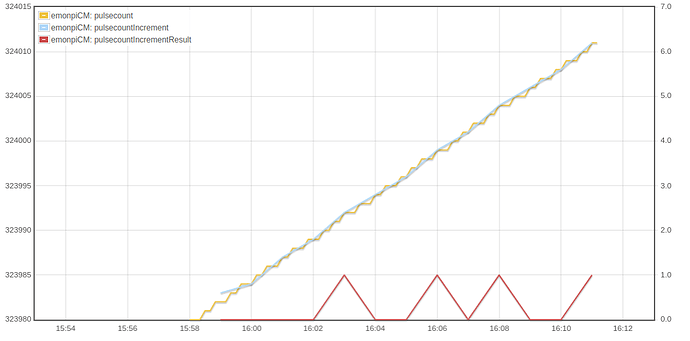Help!!! I am very, very new and very, very confused. To start with, all I want to do is create a graph of pulse increments every minute. I read in some other posts that Total Pulse count to pulse increment really is not the increment and results in the same feed as the raw pulse count feed. Indeed, that is what I can see when I try to use it. So how can I create a feed that is just the increment? In addition after I create a feed the header at the top is Arg, which I assumed is short for Argument, which tells me that is the input to the process, but it does not seem to matter whether I create a new feed for pulse increment or use the pulsecount feed. Which one should I do? Thank you
Larry
Welcome, Larry, to the OEM forum.
I’m afraid the pulse count conversions are confusing. I’ve never used Total pulse count to pulse increment, but I’ve added it to one of my inputs and here’s what I see. The “documentation” says
Returns the number of pulses incremented since the last update for a input that is a cumulative pulse count. i.e If the input updates from 23400 to 23410 the result will be an incremenet [sic] of 10.
Output: Modified value passed onto next process step.
The ability to create a feed implied to me that the increment is fed into that feed, but it’s not, it is the input value, the incrementing count, that goes into the feed. (The implication is, you don’t need to log the incrementing count before you use this.) The difference, the increment, is passed down into the next step, so if that’s what you want to log, then the next step must be Log to feed.
But note, it says “since the last update”, I take that to mean since the last pulse count was received.
Having written that, I can’t seem to be able to make it give what I think you’re asking for either. I’ve set the Toal pulse count to pulse increment to log at 1 minute intervals and this is the result - clearly it’s not doing as you want:
But a word of caution: Converting energy back to power is always a risky business, because it can only ever be historic - it’s OK if the count increment is large, but if it’s small, a low average power will come out as you can see above as 1 - 0 - 1 - 1 - 0 - 1 etc. rather than, in this case, a nice steady 140 W as measured by a current transformer.
Thank you, you have just proven what I spent a couple of hours beating my head over. If I could access the wiring I would have used CT’s, but not possible. So I am using the pulse detector. All I really want to be able to derive is some nearly instantaneous measure of load: power or current. The number of flashes per minute is what I settled on. I can count them manually or I can plot pulses over time, pick two points and divide by the time interval, manually. Any other ideas since pulse count to increment does not behave as hoped?
Larry
I’ve probably got a better idea of how Trystan thinks than you have. ![]()
If you log the accumulating pulses and convert to (k)Wh, there is kWh to Power, but that still suffers from the same problem - if there isn’t a pulse during the reporting period of your emonTx/emonPi, the power is zero.
(You can use Wh if you wish, rather than kWh, but you must fix the units!)
